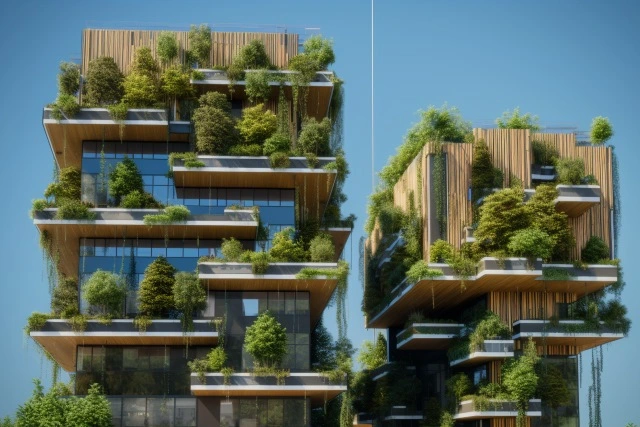Choosing the Right Green Materials for Your Commercial Building Selecting the best green materials is more than a sustainability checkbox—it’s about lowering long-term costs, enhancing tenant well-being, and ensuring compliance with ESG regulations.
Defining Green Building Materials
Green building materials are those that have a lower environmental impact throughout their lifecycle, from production and installation to long-term maintenance. The U.S. Green Building Council defines these as environmentally preferable products under its LEED certification program.
Green building materials are eco-friendly alternatives with lower environmental impact in production, installation, and maintenance. They improve energy efficiency, reduce waste, and support sustainable building practices.
What Makes a Building Material Sustainable?
The sustainability of building materials is measured by factors such as:
- Energy-efficient production: Reducing energy consumption during manufacturing.
- Resource renewability: Sourcing materials that regenerate quickly, such as bamboo.
- End-of-life recyclability: Ensuring materials can be reused or safely decomposed.
- Extended producer responsibility: Encouraging manufacturers to take back and recycle their products.
- Locally sourced: Reduces transportation emissions.
- Recycled or reclaimed: Lowers demand for virgin materials.
- Energy-efficient production: Minimizes carbon footprint.
- Durable & low-maintenance: Extends lifecycle and reduces costs.
Certified options: FSC-certified wood, LEED-approved products.Green Building Materials List 2025
| Traditional Material | Green Replacement |
| Concrete | Bendable concrete, Precast concrete, 3D printed concrete, Ferrock, Rammed earth |
| Steel | Mass timber, Reclaimed steel, Bamboo |
| Wood | Bamboo, Recycled plastic, Mass timber, Reclaimed wood |
| Insulation | Straw bale, Cellulose fiber, Sheep wool |
| Flooring | Terrazzo, Reclaimed wood, Cork |
| Other Materials | Hempcrete, Mycelium, Earth bags, Cob, Timbercrete, Recycled glass, Polyurethane |
| Concrete | Bendable concrete, Precast concrete, 3D printed concrete, Ferrock |
| Steel | Mass timber, Reclaimed steel, Bamboo |
| Wood | Bamboo, Recycled plastic, Mass timber, Reclaimed wood |
| Insulation | Straw bale, Cellulose fiber |
| Flooring | Terrazzo, Reclaimed wood |
Key Green Building Materials and Their Benefits
- Bendable Concrete (ECC): Highly flexible and 500x more crack-resistant, reducing maintenance costs and increasing longevity.
- Mass Timber: A renewable alternative to steel and concrete, reducing carbon footprint by 26.5%.
- Recycled Plastic: Converts waste into durable construction materials, reducing landfill dependency.
- Straw Bale Insulation: High insulation value and sustainable, lowering energy costs significantly.
- Terrazzo Flooring: Made from recycled glass and marble, offering durability and aesthetic appeal.
Lessons from Successful Green Buildings
Green buildings that exemplify the best use of sustainable materials include:
- The Bullitt Center (Seattle): LEED Platinum-certified, 100% solar-powered.
- Pixel Building (Melbourne): Australia’s first carbon-neutral office.
- Shanghai Tower: 40% locally sourced materials, integrated wind turbines.
How Green Materials Improve Business and Sustainability
Integrating sustainable materials benefits businesses by:
- Higher ROI: LEED-certified buildings command up to 31% higher rental premiums (CBRE study).
- Tenant Demand: 81% of tenants prefer eco-friendly buildings (Nielsen study).
- Compliance & ESG: Future-proofs assets against stricter environmental regulations.
Using ProptechOS to Ensure ESG and CSRD Compliance
While selecting sustainable materials is important, ensuring ongoing ESG and CSRD compliance can be complex. ProptechOS simplifies the process by centralizing sustainability data and streamlining reporting for evolving regulatory standards.
Choosing the right green materials is just one part of creating a sustainable commercial property. But how do you measure the real impact of these choices?
ProptechOS helps commercial real estate managers maintain ESG and CSRD compliance by automating sustainability data tracking, integrating with key performance metrics, and ensuring reporting aligns with regulatory requirements. By integrating your building’s data with ProptechOS, you can:
- Automate sustainability reporting to meet ESG and CSRD requirements.
- Reduce operational costs with data-driven insights.
- Ensure transparency and readiness for evolving compliance regulations.
Get Started with ProptechOS Today: Simplify ESG and CSRD compliance, automate sustainability tracking, and ensure your commercial property meets future regulations with ease.
